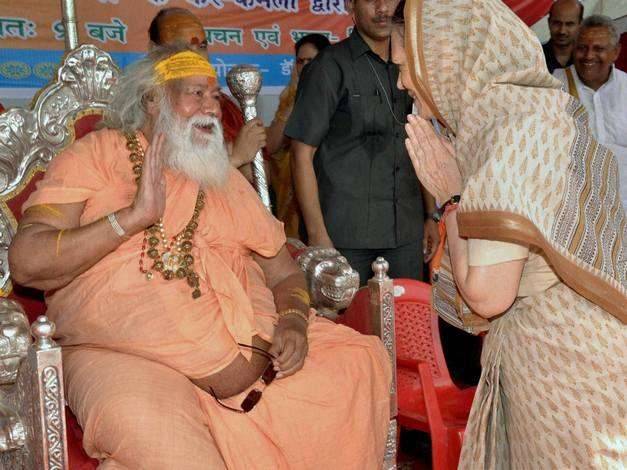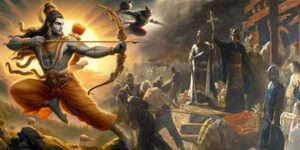The politically aligned Dwarka Sankaracharya’s tirade against Shirdi Sai Baba comes at a time when the ruling Congress-NCP is desperate to retain Maharashtra in the upcoming Assembly election
The spectre of a looming Congress-NCP defeat in the Maharashtra Assembly election, due later this year, most likely provoked the Dwarka Sankaracharya’s vituperative attack on the Sai Baba of Shirdi. The election in the nation’s financial capital is a matter of survival for both parties, as well as for Mr Raj Thackeray’s Maharashtra Navnirman Sena. The tragic murder of Pune technologist Mohsin Sheikh could not be exploited as the local media blamed coalition leaders for vitiating the atmosphere in the State.
The pro-Congress Sankaracharya’s tirade against Shirdi Sai Baba comes amidst subterranean rumours that the Congress-NCP will do anything to to retain the State. Hence the ploy to craft a Hindu-Muslim schism as reports suggest that Muslims are re-thinking their alignment with Congress and so-called secular parties, and considering having an open mind towards the BJP which won the recent parliamentary election. A second objective is to divide and confuse the Hindu devotees of Sai Baba, against whom vicious rumour-mongering has begun in several places.
Readers may recall that Swami Swaroopanand’s animus towards the BJP and its prime ministerial candidate had been so pronounced that during the recent Lok Sabha campaign he slapped a journalist who asked him about Mr Narendra Modi becoming Prime Minister. Previously, he took objection to the enthusiastic slogan, ‘Har har Modi’ and complained to the Rashtriya Swayamsevak Sangh chief, who caved in to the dismay of party workers.
The Sankaracharya has now extended his crusade against vyakti puja to Sai Baba, virtually ordering Hindus not to worship the saint as he was a human being and not a god; that reverence for Sai Baba is a conspiracy to divide Hindus; and that people are making money in his name. The Shirdi Sansthan is indeed Maharashtra’s richest shrine, with annual revenues around `100 crore, which has tempted the State Government to try to take it over in order to appropriate the offerings. The Sansthan spends most of its income on charity.
Swami Swaroopanand, who for decades has seized control of both the Dwarka and the Badrinath peethams in violation of the norms governing the mathams established by Adi Sankara, has agitated bhaktas by asserting that devotion to Sai Baba is a conspiracy to disturb the existing hierarchy of Gods: “This is a conspiracy to divide the belief of the common man. There are only two gods, Lord Ram and Krishna”. He adds without any evidence that those who do not want the Government to construct the Ayodhya temple are spreading the belief that Sai Baba was a god.
Adding insult to injury, the Sankaracharya says Sai Baba is not the epitome of Hindu-Muslim unity, or he would have been revered by Muslims as much as by Hindus. The Sanatan Dharma avers that there are 24 avatars of Vishnu; the Kaliyuga lists only Kalki and Buddha; hence Sai Baba cannot be considered an avatar, in his opinion.
It does not take much scholarship to see that the Sankaracharya’s arguments are flawed. Hindus personify their deities, claim descent from astral bodies like the sun (surya-vanshi) and moon (chandra-vanshi), and believe that the same divine spark (atma) runs through the creation, including human beings. Hence, all are worthy of worship and are worshipped, viz, earth (prithvi), trees (Pipal), plants (Tulsi), mountains (Kailash), rivers (Ganga), sky (aakash), fire (agni), wind (vayu), et al. Parents are regarded as a pilgrimage in themselves (tirth dham) and ancestral worship (shraad) is a pillar of the Hindu faith. Chaste wives are regarded as Sati (Anusuiya); husbands (karva-chauth) and children (Ahoi) revered. Chaitanya Mahaprabhu was worshipped as a personification of Vishnu in his lifetime though he does not fit the avatar timeline; in our own time, the Paramacharya of Kanchi was similarly revered. Examples of partial manifestations (ansh avatar) of the gods and goddesses abound, and need not detain us here.
Coming to Sai Baba, little is known of his life. Popular legend says he was a Muslim saint who in the mid-19th century mysteriously arrived in Shirdi as a nameless youth; lived in a forest on the outskirts of the village and meditated under a neem tree. Villagers were drawn to him and made offerings of food; at some stage, after being ejected from a Shiva temple, he moved into an abandoned mosque which he designated ‘Dwarka-mai’ (abode of Krishna). His devotees included Muslims but mainly Hindus; he preached the unity of godhead (sab ka malik ek) which is not the same as monotheism. With time, his followers erected temples in his honour in virtually every city, and because of his emphasis on feeding devotees (and dogs) he has emerged as the patron-saint of traditional food eateries.
Sai Baba was widely credited with the power to perform miracles, to see the future and save his devotees from misfortune. In some mystic circles it is said that he was among a band of revolutionaries in 1857, who fled to the Himalayas when the mutineers lost; they encountered and received training from the legendary Mahaavatar Babaji. While this is impossible to verify, the detailed biography by MV Kamath and VB Kher (Sai Baba: A Unique Saint) convincingly establishes the fact that he had formidable yogic powers.
Sai Baba acquired considerable fame in his lifetime, and according to the record of his life in Sai Charitra, Lokmanya Tilak came to Shirdi to take his blessings in the company of freedom fighter Dadasaheb Khaparde. Swami Ram Baba, the Cambridge-educated scion of the royal family of Dewas (Madhya Pradesh), had cleared the ICS when an inner voice led him to Sai Baba in 1914. Paramhamsa Yogananda’s Autobiography of a Yogi has a picture of the Swami who remained with Sai Baba in Nasik and formally took samadhi in Mumbai in 1989 at the age of 129.
It will take more than the pique of a politically aligned Sankaracharya to push an entrenched sage like Sai Baba off the Hindu pantheon. Swami Swaroopanand probably did not foresee that the shocked devotees would file complaints under Sections 295A (deliberately hurting religious sentiments) and 298 (statement given with intention to hurt religious feelings) of the Indian Penal Code. Cases have already been filed in Indore, Hyderabad and Shirdi; more may follow.
Eventually, the Sankaracharya’s lawyers will advise him to apologise and retreat as the manoeuvre has boomeranged badly. Should Prime Minister Modi decide to visit Shirdi during electioneering for the Assembly, the smear campaign would get a fitting riposte.
by Sandhya Jain






























